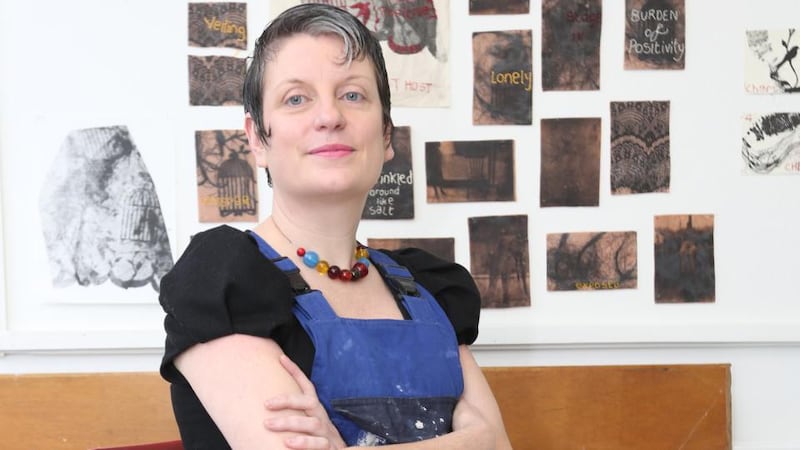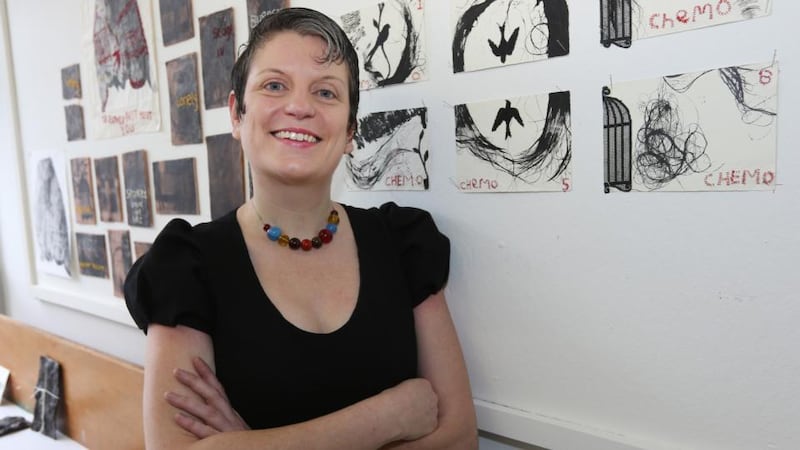I am an artist and a full-time lecturer in visual art education at Mary Immaculate College, Co Limerick. I’m also one of the founding members of Cut Out Dolls, a walkabout performing group of five women who people might recognise from the Electric Picnic and Body & Soul festivals. We create elaborate costumes made to resemble paper dress-up dolls, evoking childhood memories and historical costume.
In 2013, I became unwell with a suspected gall-bladder issue. In September 2013, I had my gall bladder removed and was then diagnosed with stage four ovarian cancer. Secondary cancers were also discovered to have originated from the ovaries. The doctors said I had to have a hysterectomy within the week. It was all very serious, and very quick, so that they could begin chemotherapy straight away.
When you have an illness such as cancer you are suddenly put in the care of someone else and you become part of a system that you may not be used to. I think it’s important to have conversations about cancer and all of its effects on the patient, their families, and support systems. Cancer support units are there for patients and their families to avail of support in a variety of ways.


I did not do a huge amount of research online but when I saw the statistics about ovarian cancer I decided that this was not me. The internet can be powerful and positive, but also shockingly dangerous.
As a spontaneous person and an art lecturer, for whom no two days are the same, one of the things I find most difficult about having a chronic illness is that I have to plan everything. Because of my treatment I have low reserves of energy, and the constant issue of fatigue curtails my life. There have been times when I have been too tired to play with my two small boys, but routine helps and every evening is spent playing and eating with them. I work on my art at night when they go to sleep.
Memory loss is another obstacle to overcome but with time my memory is improving. I usually take a nap during my break in the working day, and that helps with fatigue. My employer and colleagues have been really helpful with facilitating my return to work, which is very important to me.
Hair loss
It came as quite a shock when the chemotherapy caused hair loss, although I thought I was prepared for it. I had long brown hair and a fringe when I was diagnosed, but I had worn my hair short in college so it was quite funny at a college reunion when people told me I hadn’t changed a bit. I was fitted for several wigs, but in the end I never bought one because my head was quite sensitive and I didn’t like the idea of covering it.
Even though I was expecting it, the moment when I grabbed my own hair was horrific and emotional, and I grieved my hair. Initially I struggled with the notion of the power of hair and identity. Once I lost the hair, though, I quite enjoyed the look of it and people telling me I’ve a nice shaped head . . . although my partner is bald too, so the sight of us walking down the road together like two boiled eggs was quite funny, I imagine.
Art therapy has been very beneficial to me. In 2013 and 2014 I attended Milford Care Centre, palliative daycare centre in Limerick that provided art therapy and offered a safe and private space in which I could practise art as part of a therapeutic journey, guided by an experienced art therapist. I found this experience most profound, healing and gentle.
I believe art therapy could be beneficial to many people, regardless of whether they consider themselves artists. I would highly recommend anyone dealing with cancer or a chronic illness to give it a try to help with personal understanding and healing.
To treat my ovarian cancer, I will be on chemotherapy once every three weeks until 2016. I need to start ticking those boxes and putting those sessions behind me. I get a lot of anxiety before the treatments so I am doing a mindfulness course, which is proving very therapeutic.
Ovacare patient day
I attended my first Ovacare patient day in Galway, which is a great way of meeting people with ovarian cancer. Ovacare is the community for ovarian cancer patients, medics, families and friends.
I was chosen to talk about my illness and art at the most recent Ovacare patient day in Cork on April 11th. I tailored the talk to give an overview of my cancer journey and how I used art to express my experience. I also gave an assignment to the audience to make a small piece of meaningful and personal art using art materials that I provided. The end results were exhibited alongside my own work at the venue.
In March 2013, prior to my diagnosis, I attended an art exhibition entitled Living Loss: The Experience of Illness in Art, curated by Fiona Kearney, in the Glucksman Gallery at University College Cork with my visual art education students.
This exhibition featured work by artists such as Jo Spence, Damian Hirst and Cecily Brennan whose work confronts the reality of illness in people’s lives and showcases the phenomenon of illness from a number of different and difficult viewpoints including coping with illness and the body’s impact due to illness.
The exhibition had a profound effect on me and demonstrated the power and capacity of visual art to portray the complexity of the issues which are most salient to the human condition, in particular illness, dying and decay.
As a practising visual artist I am creating a body of work entitled Whisper, which deals specifically with my illness and its effects.
My art helps me to release a lot of emotions, including anger and frustration. I have already begun to exhibit my work in public spaces and in medical environments to help facilitate a discourse about illness. A cancer diagnosis can be a difficult topic for people to talk about. I’m not going to shout about it, but I refuse to whisper about it.
For more information, see sineaddinneenvisualartist.tumblr.com facebook.com/CutOutDolls ovacare.com milfordcarecentre.ie








